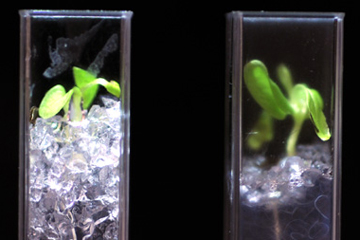See-Through Soil Could Improve Crops

(ISNS) -- Newly developed transparent soil could help shed light on the secret world of plant roots. The new material, developed by biologists, chemists and physicists, could improve crops and identify new ways of preventing outbreaks of food poisoning.
Plants absorb water and minerals with root systems that can encompass a volume larger than the above-ground parts of plants. Scientists would love to learn more about roots, but much about them remains hidden underground.
"There are so many things to discover in soil, and we don't know yet what they are," said theoretical biologist Lionel Dupuy at the James Hutton Institute in Dundee, Scotland.
Now, after two years of trial and error involving painstaking tinkering with the acidity, grain size and nutrient content of a variety of artificial soil-like materials, watered in a customized liquid solution, Dupuy and his colleagues managed to develop a transparent soil in which they could grow plants. The material allows 3-D imaging of the rhizosphere -- the realm of soil involving plant roots and the organisms associated with them.
The soil is made of 350-to-1,600-micron-wide pellets of a synthetic material known as Nafion. This compound often finds use in power-generating fuel cells because of how it can help control the flow of current-carrying ions. Past research revealed that the material had another talent: films of bacteria could grow on Nafion membranes. Also, the scientists could modify the Nafion grains to bind to ions dissolved in the surrounding liquid solution, mimicking natural soil chemistry.
This artificial soil is not especially transparent on its own. However, when saturated with a specially designed water-based solution, the way the soil and the solution each bend or "refract" light renders the combination transparent. A similar effect can be seen if you place one clear glass jar in another clear glass jar and fill the smaller jar and the space between jars with paint thinner — the smaller jar will seem to disappear.
Although this material does not perfectly mimic real soil, its physical and chemical qualities are close.
Get the world’s most fascinating discoveries delivered straight to your inbox.
"This is huge progress," said plant biologist Laurent Laplaze at the French Institute of Research for Development in Montpellier, who did not take part in this study. "This is a completely new way to look at roots in a more realistic setup than usually used. It is a major technical breakthrough that opens new avenues for plant physiology, plant breeding and the study of plant-microbe interactions."
Dupuy and his colleagues used transparent soil to analyze how potentially lethal E. coli bacteria interacted with lettuce roots. Although E. coli is normally a beneficial microbe in our guts that fights bad bacteria and can even help produce necessary vitamins, dangerous strains can cause severe food poisoning. The researchers used a genetically modified version of E. coli that carried a green fluorescent protein from jellyfish and watched how it behaved with lettuce. They saw the bacterium form micro-colonies in the root zone that likely helps them survive outside of guts.
"If we understand better the contamination route, then we can develop strategies to limit the transfer of E. coli to the food chain," Dupuy said. "We don't really understand how E. coli enters the food chain, particularly for fresh produce."
Transparent soils could be used to study the spread and transmission of other soil-borne infections.
"For example, nematode worms are responsible for the transmission of viruses to crops, and transparent soils could be used to study their feeding habits," Dupuy said.
Transparent soils could also help analyze the roots of a range of plant varieties, which would help to breed crops with more efficient root systems so that agriculture can use less water and fertilizers.
"Root traits have been little used in breeding programs because basically it was very difficult to conduct high-throughput analysis of root architecture in soil conditions," Laplaze said. "The transparent soil approach now opens new avenues for this."
For instance, scientists could genetically modify plants so that key growth hormones and other compounds are tagged with fluorescent proteins. This would help researchers track how these molecules circulate in live plants and see how roots behave, which could shed light on why some plants do better than others under the same growing conditions.
"If we want to make crops and agriculture more efficient, we need to gather information at the molecular level so that we can breed more efficiently for advantageous root traits," Dupuy said.
Future research will endeavor to find a way to bring down costs on transparent soil, as Nafion is quite expensive, Dupuy added. For instance, a transparent soil based on the Teflon family of materials might be possible, he explained.
The scientists detailed their findings online Sept. 11 in the journal PLoS ONE.
Charles Q. Choi is a freelance science writer based in New York City who has written for The New York Times, Scientific American, Wired, Science, Nature, and many other news outlets.
Inside Science News Service is supported by the American Institute of Physics.



